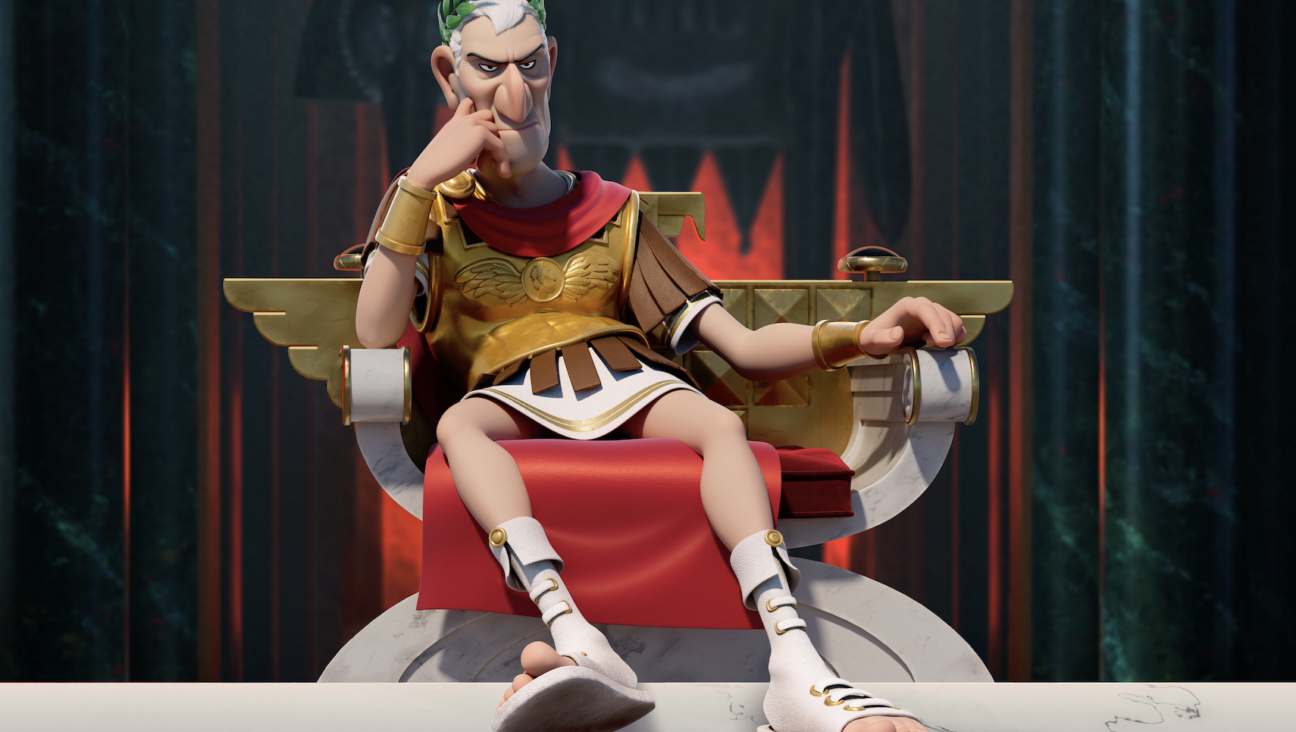Why ‘Jojo Rabbit’ is heading to a classroom near you

Image by KIMBERLEY FRENCH FOR 20TH CENTURY FOX
Last year, “Jojo Rabbit,” the Hitler Youth satire by Taika Waititi, charmed audiences and baffled skeptics, managing to be whimsical, winning and kind-hearted — while also featuring an imaginary Adolf Hitler who dines on unicorns. Now, the Oscar-winning film is on its way to classrooms as a teaching tool, aimed at educating young people about the historical reality that inspired it.
In the fall, the USC Shoah Foundation, which had seen an early screening of the film. teamed up with Searchlight Pictures (formerly Fox Searchlight) to integrate it into their curriculum.
“Everyone, I think, could see the enormous potential that the film could bring to promoting understanding around anti-Semitism, humanizing of ‘The Other,’ promoting empathy,” said Claudia Ramirez Weideman, associate director of education technologies and training for the foundation. “It was a no-brainer.”
Since 1994, the Shoah Foundation, based at the University of Southern California, has been committed to preserving the testimony of genocide survivors and witnesses for the purposes of building media literacy, historical understanding and empathy among middle and high school students. The “Jojo Rabbit Education Initiative,” launched last December, pairs the foundation’s digital history archive with materials from Waititi’s film, which follows Jojo, a member of the Hitler Youth whose mother is hiding a Jewish girl in their flat.
The Foundation has devoted a landing page to the film on their IWitness website, where educators and students can access notes on the film, featurettes and video testimony from eight survivors, recalling their memories of the Hitler Youth. Some of the survivors remember when their classmates, and even close friends, became involved in the Hitler Jugend, while others recall violence inflicted on Jews by members of the movement.
“Many times I came to school very late just trying to avoid these Hitler Jugend,” Esther Clifford said in her video testimony, remembering how the young men, in their brown uniforms, would throw rocks at Jewish kids.
“I went with my wife to go to a store and there was a group of Hitler Jugend — rotten kids — coming, and they fell on me and then beat me to a pulp,” survivor Eric Nash recalled.
“We have about 1,000 testimonies in our digital history archive, where survivors and other witnesses talk about the Hitler Youth one way or another,” said Weidman. “They can speak to the time of this film and therefore, we can use it to engage students in really powerful ways that film alone may not be able to accomplish.”
Waititi’s film is a manic take on the Hitler Youth program, employing humor to highlight the absurdity of hate and indoctrination. Waititi cast himself as Jojo’s imaginary friend, a childishly spiteful version of Adolf Hitler. The other Nazi adult characters — played by Sam Rockwell, Alfie Allen and Rebel Wilson — are presented as dogmatic, myopic or incompetent while a crew of eerie “clones,” parodies of perfect Aryan children, point to the strangeness of Nazi racial purity.
“Because of this absurdity — the things that we see in films like this — it necessarily leads to questioning,” Weidman said. “Students wonder ‘Why are they making fun of this; why is this funny?’”
Included on the “Jojo Rabbit” page is a primer on satire and the Holocaust, referencing Charlie Chaplin’s “The Great Dictator,” Ernst Lubitsch’s “To Be or Not To Be” and, Waititi’s hero Mel Brooks’s “The Producers.” (After winning his Oscar for Best Adapted Screenplay, Waititi said that Mel Brooks’ approval of the film and the Shoah Foundation’s choice to use it in their curriculum were among the most meaningful recognitions he had received.)
The website, which can be used as a resource both before and after viewing the film, also features an activity called “Hiding” that connects the experience of Jojo’s hidden neighbor, Elsa, to the testimony of survivor Aaron Elster. Elster hid in an attic during the war and, like Elsa, spied on a child that lived below him. Students are asked to respond to Elster’s memories and imagine what it was like for him to live in hiding.
Other exercises have students study propaganda — of the kind the Hitler Youth leaders task Jojo with distributing in one of the film clips on the website — and hear testimony on othering, anti-Semitism and the bystander effect and reflect on what they see through worksheets, charts and poetry. The activities are programmed for late middle school and early high school students.
Weidman says she’s yet to receive feedback from educators, but noted that it often takes awhile for teachers to incorporate new items into their lesson plans. And more new material will be coming to the “Jojo Rabbit” page.
“That’s how confident we feel about the film,” Weidman said.
PJ Grisar is the Forward’s culture fellow. He can be reached at [email protected].
The Forward is free to read, but it isn’t free to produce

I hope you appreciated this article. Before you go, I’d like to ask you to please support the Forward.
Now more than ever, American Jews need independent news they can trust, with reporting driven by truth, not ideology. We serve you, not any ideological agenda.
At a time when other newsrooms are closing or cutting back, the Forward has removed its paywall and invested additional resources to report on the ground from Israel and around the U.S. on the impact of the war, rising antisemitism and polarized discourse.
This is a great time to support independent Jewish journalism you rely on. Make a gift today!
— Rachel Fishman Feddersen, Publisher and CEO
Support our mission to tell the Jewish story fully and fairly.
Most Popular
- 1

News School Israel trip turns ‘terrifying’ for LA students attacked by Israeli teens
- 2

Culture Cardinals are Catholic, not Jewish — so why do they all wear yarmulkes?
- 3

Fast Forward Why the Antisemitism Awareness Act now has a religious liberty clause to protect ‘Jews killed Jesus’ statements
- 4

Fast Forward Ye debuts ‘Heil Hitler’ music video that includes a sample of a Hitler speech
In Case You Missed It
-

Yiddish קאָנצערט לכּבֿוד דעם ייִדישן שרײַבער און רעדאַקטאָר באָריס סאַנדלערConcert honoring Yiddish writer and editor Boris Sandler
דער בעל־שׂימחה האָט יאָרן לאַנג געדינט ווי דער רעדאַקטאָר פֿונעם ייִדישן פֿאָרווערטס.
-

Fast Forward Trump’s new pick for surgeon general blames the Nazis for pesticides on our food
-

Fast Forward Jewish feud over Trump escalates with open letter in The New York Times
-

Fast Forward First American pope, Leo XIV, studied under a leader in Jewish-Catholic relations
-
Shop the Forward Store
100% of profits support our journalism
Republish This Story
Please read before republishing
We’re happy to make this story available to republish for free, unless it originated with JTA, Haaretz or another publication (as indicated on the article) and as long as you follow our guidelines.
You must comply with the following:
- Credit the Forward
- Retain our pixel
- Preserve our canonical link in Google search
- Add a noindex tag in Google search
See our full guidelines for more information, and this guide for detail about canonical URLs.
To republish, copy the HTML by clicking on the yellow button to the right; it includes our tracking pixel, all paragraph styles and hyperlinks, the author byline and credit to the Forward. It does not include images; to avoid copyright violations, you must add them manually, following our guidelines. Please email us at [email protected], subject line “republish,” with any questions or to let us know what stories you’re picking up.
















